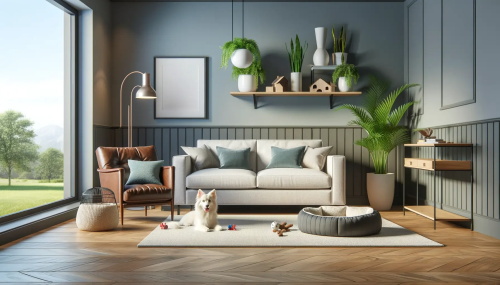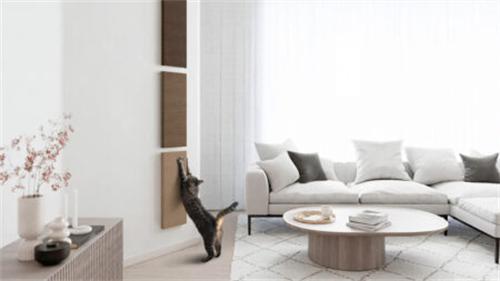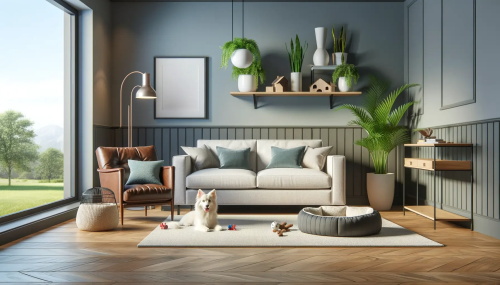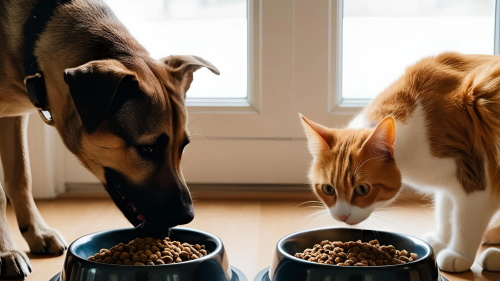How to Create a Pet-Friendly Home: Furniture, Layout, and Safety Tips

Creating a pet-friendly home is more than just making room for your furry companions; it's about designing an environment where both humans and animals can live comfortably, safely, and happily. A well-planned space can enrich your pet's life, prevent damage, and maintain harmony in your home.
Whether you've just adopted a puppy or kitten or have lived with these loyal companions for years, creating a home that meets everyone's needs is an art form. Let's explore how to design a stylish and practical pet-friendly home, from choosing the right furniture and layout to ensuring safety and cleanliness.
The Importance of a Pet-Friendly Home
Pets are more than just visitors to our homes; they are family members. Like children, they need a sense of security, stimulation, and comfort. A pet-friendly home not only supports pets' health but also minimizes the stress and risks that can come with sharing a living space.
When pets feel safe, they are less likely to engage in destructive behaviors, such as scratching furniture, chewing on electrical cords, or marking their territory. Furthermore, a pet-friendly home design can reduce stress for owners—no worries about spills, messes, or damaged decor means more time to bond and play with your pet.
A truly pet-friendly home strikes a balance between human needs and animal instincts. It's more than just putting a kennel in the corner; it's about designing an environment that respects your pet's natural behaviors while also accommodating your lifestyle and tastes.
Choosing Pet-Friendly Furniture
1. Choose Durable, Pet-Resistant Materials
Pet claws, paws, and hair put the strain on your furniture's durability. Choosing the right material is crucial. Leather and tightly woven fabrics like microfiber are popular because they're scratch-resistant, resist hair stains, and are easy to clean.
For example, leather doesn't absorb hair or odors and can be easily wiped with a damp cloth. Microfiber offers a suede-like feel but is more resistant to the wear and tear of claws and dirt. For a more comfortable look, Crypton-treated fabrics are not only water- and stain-resistant, but also maintain comfort.
Avoid loose fabrics that snag easily, such as linen or tweed. Remember, dark fabrics tend to trap dirt and hair, while patterned fabrics can hide stains and scratches.
2. Use washable or replaceable covers
Washable sofa covers or removable cushion covers are essential for pet owners. They protect your furniture from hair, drool, and the occasional accident. They also allow you to easily change up your interior decor—simply by switching up the color or texture with the season.
If you prefer a minimalist style, cover your sofa or bed with a soft, washable blanket. These are easy to clean and keep your furniture clean.
3. Avoid delicate or high-maintenance fabrics
Silk, velvet, and chintz may look luxurious, but they're not ideal for homes with pets. They attract hair, absorb oils, and can cause permanent damage if a pet's claws get caught. Instead of looking like something out of a magazine photo, consider practicality and choose furniture that can withstand real life.
Design a Functional Layout
A pet-friendly home layout should accommodate your daily life while also making your pet feel comfortable. Thoughtful design choices can reduce clutter, improve movement, and make your pet feel right at home.
1. Create Clear Paths
Ensure your pet has ample space to move around without bumping into furniture or knocking over decorative items. This is especially important for elderly pets, large dogs, or pets with mobility issues. An open layout also allows your pet to observe their surroundings without feeling cramped.
2. Designate Pet Areas
Just like humans have bedrooms and offices, pets need their own "areas." Create distinct areas for feeding, sleeping, and playing. For example, a cozy bed under a side table can serve as a dog's den, while a cat tree near a sunny window can satisfy your cat's curiosity.
Using rugs or mats can help define these areas while protecting the floor from stains and scratches. Choose machine-washable or waterproof mats for easy maintenance.
3. Integrate pet furniture into your decor
Gone are the days of bulky cages and unsightly litter boxes. Modern pet furniture combines style and practicality—think chic dog beds that double as footstools or cat stands that look like art installations. Matching pet supplies to your home style helps maintain a cohesive space and avoid visual clutter.
You can even repurpose existing furniture to create DIY pet-friendly pieces. For example, you could transform a hollow coffee table into a hidden pet nest or hide the litter box in a fume hood.
Ensure Pet Safety
A home designed for pets must be both safe and comfortable. Preventing accidents and protecting your furry friends from harm is an essential part of pet-friendly living.

1. Safely Store Dangerous Items
Pets are naturally curious, and this curiosity can get them into trouble. Store cleaning supplies, medicine, and sharp objects in cabinets with childproof locks. Keep trash cans covered or out of reach of children to prevent them from rummaging through the trash.
If you have plants, make sure they are non-toxic—many popular houseplants, such as lilies, philodendrons, and poinsettias, can be dangerous if ingested by cats and dogs.
2. Manage Cords and Wires
Puppies and kittens are particularly attracted to overhanging wires. Using cord covers or hiding cords behind furniture can prevent them from chewing on them. Wireless devices or smart plugs can also reduce the number of visible wires in your home.
3. Install Safety Gates and Barriers
Safety gates can be used to restrict pet access to certain areas, such as the kitchen, stairways, or children's playrooms. They can help with pet training and prevent them from entering unsafe or sensitive spaces.
4. Pet-Proof Windows and Balconies
Ensure windows and balconies are secure. Use sturdy screens and regularly inspect them for damage or weaknesses. For high-rise apartments, consider installing pet-safe balcony railings to prevent falls or escapes.
5. Choose non-toxic, low-VOC materials
When decorating or painting, use pet-safe materials with low or zero VOC content. These materials are less likely to irritate your pet's respiratory system or cause allergic reactions.
Promote Pet Comfort and Enrichment
A pet-friendly home environment should stimulate your pet's senses and provide both physical and mental satisfaction. Boredom often leads to destructive behavior, so proactive design is crucial.
1. Provide Interactive Toys
Provide a variety of toys—chew toys, puzzles, squeaky toys, and feather wands—to keep your pet entertained and engaged. Rotate toys regularly to maintain their interest.
2. Create Vertical Space
Cats and small pets love to climb and observe from high vantage points. Cat climbing frames, climbing racks, and window sills allow them to safely explore their surroundings. Vertical space also helps prevent territorial disputes in multi-pet households.
3. Provide Comfortable Resting Places
Every pet needs a place to rest and recharge. Choose a soft, supportive bed in a quiet corner, away from high-traffic areas. Orthopedic beds are ideal for older pets, while loft beds help improve air circulation in warm climates.
4. Allow for natural light
Locate your pet's play area near a window so they can enjoy the sun and the beauty of the outdoors. Sunbathing is not only comfortable but also beneficial for their circadian rhythm and mood.
Blend style and function
A well-designed pet-friendly home doesn't have to look like a doghouse. The secret lies in seamlessly integrating pet functionality with your personal aesthetic.
Choose furniture and accessories that complement your home's style while also being practical. Neutral colors help conceal fur, while sleek, modern furniture easily organizes pet supplies and reduces clutter. Storage benches, woven baskets, and stylish organizers can cleverly organize toys, leashes, and grooming supplies.
Personalize your space with pet-themed decor, but maintain balance. A framed paw print or an elegant portrait can add a touch of personality without overwhelming the home.
The Emotional Element: Creating a True Pet Home
Beyond spatial design, a pet-friendly home fosters emotional connections. A pet's comfort reflects the home's vitality. A quiet, predictable environment helps pets feel secure, while loud noises, clutter, or unpredictable schedules can trigger anxiety.
Integrate your pet into your family's daily routine—let them relax by your side during movie night or create a cozy space in the shared living area where they always feel included. The ultimate goal is not just to create a pet-safe home, but one where your pet thrives as a full-fledged member of the family.
Creating a pet-friendly home is an ongoing and rewarding process. It involves understanding your pet's habits, anticipating their needs, and designing a space that works with your lifestyle.
By choosing durable, easy-to-clean materials, ensuring safety, and providing areas for play and rest, you can create a home that is both stylish and inviting. Remember: a pet-friendly home doesn't have to sacrifice aesthetics; it's about enriching the lives of both you and your pet. When your pet feels safe, loved, and accepted, your house truly becomes a home.



